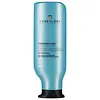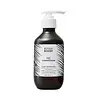What's inside
What's inside
 Key Ingredients
Key Ingredients

 Benefits
Benefits

 Concerns
Concerns

 Ingredients Side-by-side
Ingredients Side-by-side

Water
Skin ConditioningCetearyl Alcohol
EmollientBehentrimonium Chloride
PreservativeAmodimethicone
Parfum
MaskingIsopropyl Alcohol
SolventPhenoxyethanol
PreservativeBenzoic Acid
MaskingTrideceth-6
EmulsifyingHexyl Cinnamal
PerfumingTocopherol
AntioxidantOlea Europaea Fruit Oil
MaskingCamelina Sativa Seed Oil
Skin ConditioningPoly(Linseed Oil)
Butylene Glycol
HumectantLinalool
PerfumingPotassium Hydroxide
BufferingDilauryl Thiodipropionate
AntioxidantArginine
MaskingCetrimonium Chloride
AntimicrobialHelianthus Annuus Seed Extract
Skin ConditioningHydrolyzed Vegetable Protein Pg-Propyl Silanetriol
Skin ConditioningLimonene
Perfuming2-Oleamido-1,3-Octadecanediol
Skin ConditioningCitric Acid
BufferingBenzophenone-4
UV AbsorberCitronellol
PerfumingHaematococcus Pluvialis Extract
AntioxidantCI 14700
Cosmetic ColorantCaprylic/Capric Triglyceride
MaskingPotassium Sorbate
PreservativeCI 15510
Cosmetic ColorantWater, Cetearyl Alcohol, Behentrimonium Chloride, Amodimethicone, Parfum, Isopropyl Alcohol, Phenoxyethanol, Benzoic Acid, Trideceth-6, Hexyl Cinnamal, Tocopherol, Olea Europaea Fruit Oil, Camelina Sativa Seed Oil, Poly(Linseed Oil), Butylene Glycol, Linalool, Potassium Hydroxide, Dilauryl Thiodipropionate, Arginine, Cetrimonium Chloride, Helianthus Annuus Seed Extract, Hydrolyzed Vegetable Protein Pg-Propyl Silanetriol, Limonene, 2-Oleamido-1,3-Octadecanediol, Citric Acid, Benzophenone-4, Citronellol, Haematococcus Pluvialis Extract, CI 14700, Caprylic/Capric Triglyceride, Potassium Sorbate, CI 15510
Aloe Barbadensis Leaf Juice
Skin ConditioningCetearyl Alcohol
EmollientGlycerin
HumectantCoco-Caprylate
EmollientBehentrimonium Chloride
PreservativePolyquaternium-10
Polyquaternium-7
Argania Spinosa Kernel Oil
EmollientMentha Piperita Oil
MaskingPanthenol
Skin ConditioningMentha Arvensis Callus Lysate
AntioxidantHydrolyzed Quinoa
Skin ConditioningLinum Usitatissimum Seed Oil
PerfumingHelianthus Annuus Seed Oil
EmollientSqualane
EmollientSimmondsia Chinensis Seed Oil
EmollientMacadamia Ternifolia Seed Oil
EmollientUrtica Dioica Leaf Extract
Skin ConditioningEquisetum Arvense Leaf Extract
AstringentHibiscus Sabdariffa Flower Extract
Skin ConditioningHylocereus Undatus Fruit Extract
Skin ConditioningChamomilla Recutita Flower Extract
MaskingRosmarinus Officinalis Leaf Extract
AntimicrobialSerenoa Serrulata Fruit Extract
Skin ConditioningPentylene Glycol
Skin ConditioningCaprylyl Glycol
EmollientEthylhexylglycerin
Skin ConditioningCitric Acid
BufferingAloe Barbadensis Leaf Juice, Cetearyl Alcohol, Glycerin, Coco-Caprylate, Behentrimonium Chloride, Polyquaternium-10, Polyquaternium-7, Argania Spinosa Kernel Oil, Mentha Piperita Oil, Panthenol, Mentha Arvensis Callus Lysate, Hydrolyzed Quinoa, Linum Usitatissimum Seed Oil, Helianthus Annuus Seed Oil, Squalane, Simmondsia Chinensis Seed Oil, Macadamia Ternifolia Seed Oil, Urtica Dioica Leaf Extract, Equisetum Arvense Leaf Extract, Hibiscus Sabdariffa Flower Extract, Hylocereus Undatus Fruit Extract, Chamomilla Recutita Flower Extract, Rosmarinus Officinalis Leaf Extract, Serenoa Serrulata Fruit Extract, Pentylene Glycol, Caprylyl Glycol, Ethylhexylglycerin, Citric Acid
 Reviews
Reviews

Ingredients Explained
These ingredients are found in both products.
Ingredients higher up in an ingredient list are typically present in a larger amount.
This ingredient is a preservative and often used for it's anti-static properties. You'll most likely see this ingredient in hair conditioners.
It does not cause irritation or sensitization in leave-on products at 1-5%.
Cetearyl alcohol is a mixture of two fatty alcohols: cetyl alcohol and stearyl alcohol. It is mainly used as an emulsifier. Emulsifiers help prevent the separation of oils and products. Due to its composition, it can also be used to thicken a product or help create foam.
Cetearyl alcohol is an emollient. Emollients help soothe and hydrate the skin by trapping moisture.
Studies show Cetearyl alcohol is non-toxic and non-irritating. The FDA allows products labeled "alcohol-free" to have fatty alcohols.
This ingredient is usually derived from plant oils such as palm, vegetable, or coconut oils. There is debate on whether this ingredient will cause acne.
Due to the fatty acid base, this ingredient may not be Malassezia folliculitis safe.
Learn more about Cetearyl AlcoholCitric Acid is an alpha hydroxy acid (AHA) naturally found in citrus fruits like oranges, lemons, and limes.
Like other AHAs, citric acid can exfoliate skin by breaking down the bonds that hold dead skin cells together. This helps reveal smoother and brighter skin underneath.
However, this exfoliating effect only happens at high concentrations (20%) which can be hard to find in cosmetic products.
Due to this, citric acid is usually included in small amounts as a pH adjuster. This helps keep products slightly more acidic and compatible with skin's natural pH.
In skincare formulas, citric acid can:
While it can provide some skin benefits, research shows lactic acid and glycolic acid are generally more effective and less irritating exfoliants.
Most citric acid used in skincare today is made by fermenting sugars (usually from molasses). This synthetic version is identical to the natural citrus form but easier to stabilize and use in formulations.
Read more about some other popular AHA's here:
Learn more about Citric Acid